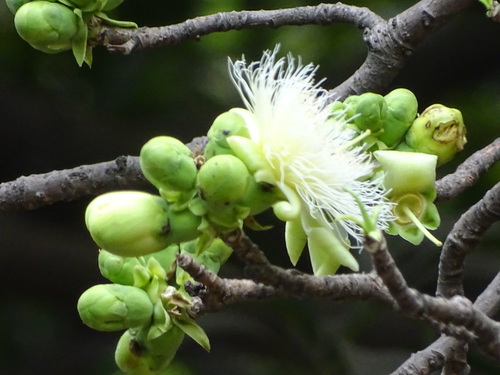Botanical name: Careya arborea | Hindi: कुम्भी | Marathi: कुम्भा | English: Wild Guava
About
The Wild Guava, also known as कुम्भी (Kumbhi) in Hindi and Careya arborea by its scientific name, is a majestic deciduous tree native to the Indian subcontinent, Afghanistan, and Indochina. Reaching heights of 15-20 meters, it stands tall with its spreading crown and distinctive features. Its leaves, arranged spirally, are broad and obovate, turning a vibrant red during the cold season. During blooming, it dazzles with fragrant white or yellow flowers, followed by round, green fruits that mature into leathery capsules with edible pulp. Its bark is dark grey and fissured, adding a rustic charm to its presence.
Interesting Facts

Medicinal Uses: Beyond its captivating beauty, Wild Guava boasts a rich medicinal history in traditional Indian medicine. Its bark, leaves, and even the fruit’s gum hold potential health benefits. The bark and leaves are known for their astringent properties, used to treat coughs, colds, and diarrhea. The gum, traditionally called “katha,” finds use in treating wounds, ulcers, and even epilepsy. Additionally, the bark fibers are used as coarse cordage, and the wood finds application in various carpentry projects. However, it’s crucial to consult a healthcare professional before using any part of the tree due to potential side effects.

Culture & Tradition: More than just a medicinal marvel, Wild Guava holds deep cultural significance in India. Its Sanskrit name, “Kumbhi,” refers to the water-pot-like shape of its fruit, and the tree itself finds mention in ancient texts. In some regions, it’s considered sacred and planted near temples for religious offerings. In tribal communities, the bark and leaves find use in traditional rituals and practices for purification and spiritual protection. Its association with resilience and its vibrant red foliage during winter make it a symbol of strength and prosperity in some cultures.

Environmental Impact: Wild Guava plays a vital role in maintaining ecological balance. Its deep roots help prevent soil erosion, and its dense foliage provides habitat and food for various birds and insects. The nectar-rich flowers attract pollinators, contributing to biodiversity. Additionally, its wood is known for its durability and termite resistance, making it a sustainable choice for construction and furniture in some regions. Furthermore, its bark exudate is traditionally used as an organic pesticide, offering an eco-friendly alternative to harmful chemicals.

Food & Culinary usage: While not extensively used in mainstream cuisine, Wild Guava offers intriguing culinary possibilities. The mature fruit’s edible pulp has a tangy, mildly sweet flavor, sometimes used in jams, pickles, and chutneys. The flower buds are occasionally pickled or fried as snacks. In certain regions, the leaves are dried and powdered for use in spice blends or as a thickener in soups. However, it’s essential to remember that the seeds are considered slightly poisonous and should be avoided.

